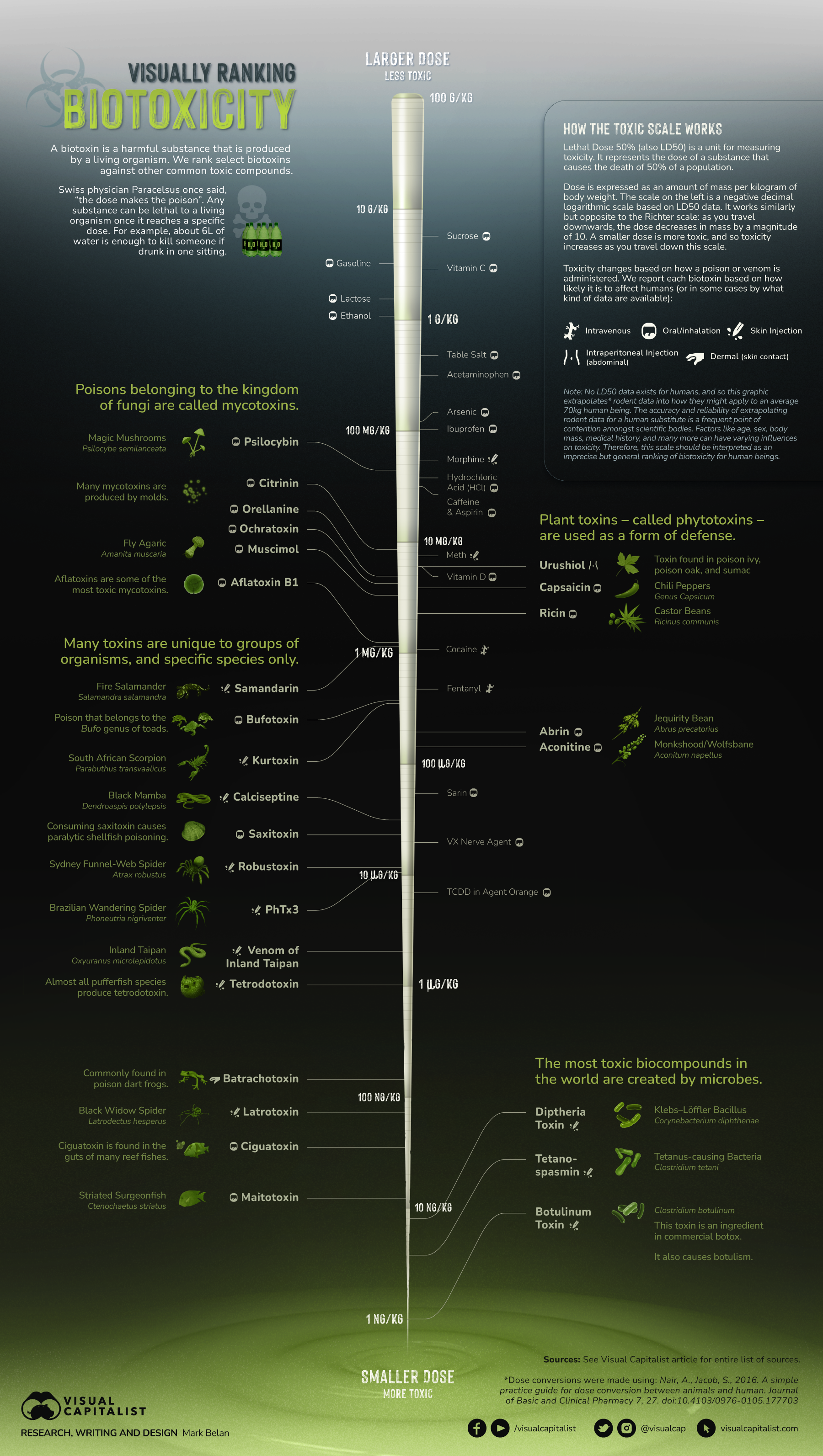Biotoxins are toxic substances produced by living organisms, such as bacteria, fungi, algae, plants, and animals. These toxins can cause illness or death in other organisms, including humans. Biotoxins can be found in various environments, including marine and freshwater ecosystems, as well as in the soil and air.
Some examples of biotoxins include:
- Toxins produced by harmful algal blooms (HABs), such as domoic acid, saxitoxin, and brevetoxin, which can cause neurological and gastrointestinal symptoms in humans and marine animals.
- Venom produced by snakes, spiders, scorpions, and other animals, which can cause pain, swelling, and even death in some cases.
- Toxins produced by certain species of bacteria, such as botulinum toxin, which causes botulism, a potentially fatal illness characterized by muscle paralysis.
- Toxins produced by some plants, such as poison ivy and poison oak, which can cause skin irritation and allergic reactions.
- Biotoxins can be harmful to human health, and exposure to them can occur through ingestion, inhalation, or contact with the skin. It is important to be aware of the potential risks associated with biotoxins and to take appropriate precautions to avoid exposure.
Infographic below was created by visualcapitalist illustrates some common biotoxins in the natural world and ranked them based on how poisonous they are to an average 70 kg (154 lb) human being.
Here are some interesting facts about biotoxins and our relationships with the organisms that create them:
- Biotoxins can be both harmful and beneficial: While many biotoxins are harmful and can cause illness or death in humans and animals, some biotoxins have beneficial effects. For example, certain biotoxins produced by bacteria are used in medical treatments such as botulinum toxin, which is used to treat muscle spasms and wrinkles.
- Mycotoxins (poisons produced by fungi and molds) are a global problem. They impact crops from many nations, and can cause considerable economic losses for farmers and food producers.
- Some biotoxins have been used as weapons: Biotoxins have been used as weapons throughout history, from poisoned arrows to modern-day chemical weapons. One example is the biotoxin ricin, which is derived from the castor bean plant and has been used as a poison for centuries.
- Batrachotoxin is fatal to the touch: The skin of some poison dart frogs excretes a harmful substance called batrachotoxin. It is so powerful that only touching the poison can be lethal. Indigenous people of Central and South America used batrachotoxin to poison the tips of hunting spears for centuries.
- Some biotoxins are used for defense: Many organisms, such as certain species of snakes, spiders, and plants, produce biotoxins as a defense mechanism against predators. These toxins can be deadly to predators, and can even be used to protect humans from potential threats.
- Ciguatoxins protec reef fish: Bacteria existing in the digestive tract of reef fishes make ciguatoxin. They transmit this toxin to other organisms when the reef fish is bitten.
- Humans have developed a tolerance to some biotoxins: Some cultures have developed a tolerance to certain biotoxins, allowing them to consume foods that would be poisonous to others. For example, the Japanese have developed a tolerance to the biotoxin tetrodotoxin, which is found in pufferfish and can be deadly if consumed in large quantities.
- Biotoxins are being studied for potential medical applications: Researchers are studying biotoxins for their potential medical applications, such as developing new treatments for diseases like cancer. For example, the venom of the cone snail contains a compound that has been shown to have pain-relieving properties and is being studied as a potential alternative to opioids.
- Plants use phytotoxins to protect themselves against other organisms, like humans: Urushiol, for instance, is the main toxic component in the leaves of poison ivy, poison oak, and sumac. But the Pacific yew tree produces taxol that’s useful in chemotherapy therapies.
- Salamander toxins as an ingredient in whisky: Some whisky creators in Slovenia use samandarine from the fire salamander to make a psychedelic alcohol.
- Pufferfish are dangerous, but also delicious: A harmful neurotoxin in pufferfish ovaries, liver, and skin contains tetrodotoxin. Despite being a delicacy in many nations worldwide, it has a lot of strict limitations because of its ability to poison people. In Japan, for instance, only specially certified cooks can prepare pufferfish for consumption.
- Botox contains the most harmful biotoxin known: Commercial botox uses an infinitesimal amount of biotoxin from a microbe called Clostridium botulinum. It paralyzes the muscles, stopping contraction. It is the deadliest known biotoxin on our planet. One gram of botulinum toxin able kill up to one million people.

This post may contain affiliate links. As an Amazon Associate, I earn from qualifying purchases.
Comments
Post a Comment